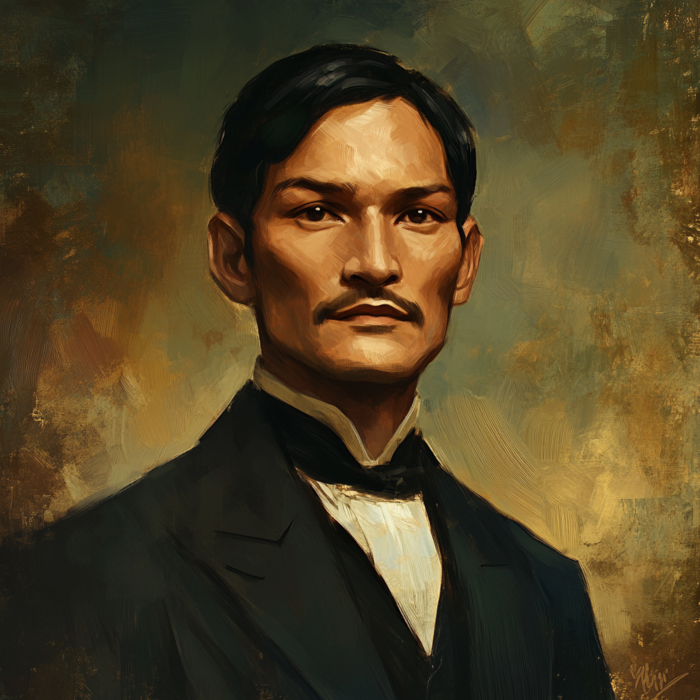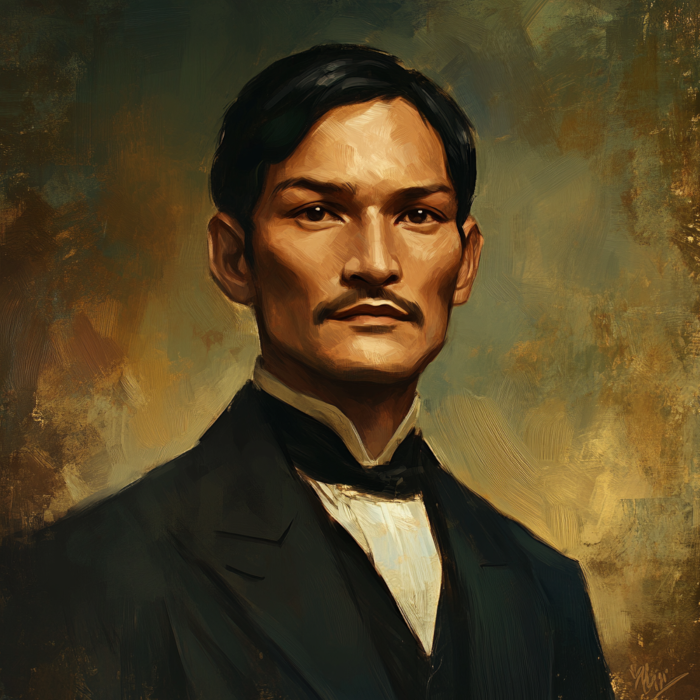


José Rizal (1861–1896) was a Filipino nationalist, polymath, writer, and revolutionary who is widely regarded as the national hero of the Philippines. His writings, particularly his novels Noli Me Tangere (1887) and El Filibusterismo (1891), were instrumental in inspiring the Philippine Revolution against Spanish colonial rule. Rizal's work focused on the political, social, and cultural conditions under Spanish colonialism, advocating for peaceful reforms rather than violent revolution. His execution in 1896 made him a martyr and further galvanized the movement for Philippine independence.
Birth and Family Background: José Protacio Rizal Mercado y Alonzo Realonda was born on June 19, 1861, in Calamba, Laguna, in the Philippines, which was then a Spanish colony. He came from a wealthy family of Filipino, Chinese, and Spanish ancestry, with his father, Francisco Mercado, being a prosperous landowner and his mother, Teodora Alonso, a highly educated woman. Rizal was the seventh of eleven children.
Education in the Philippines: Rizal was exceptionally intelligent from a young age and learned to read and write early under his mother’s guidance. He attended the Ateneo Municipal de Manila, where he earned a Bachelor of Arts degree in 1877, and later enrolled at the University of Santo Tomas to study medicine. However, Rizal faced racial discrimination at the university, which deepened his awareness of the injustices experienced by Filipinos under Spanish rule.
Studies Abroad: In 1882, Rizal left the Philippines to study in Europe. He studied medicine at the Universidad Central de Madrid, earning his medical degree in 1884. Rizal also studied ophthalmology in Paris and Heidelberg, specializing in eye surgery to treat his mother’s blindness. His time in Europe exposed him to liberal and nationalist ideas, which profoundly shaped his political thinking.
Noli Me Tangere (1887): Rizal’s first novel, Noli Me Tangere (Touch Me Not), was published in Berlin in 1887. The novel exposed the abuses of Spanish colonialism, particularly by the clergy and the government, and portrayed the suffering of the Filipino people. Through the character of Crisostomo Ibarra, a young man who returns to the Philippines after studying in Europe, Rizal expressed his call for social reforms, justice, and the education of the Filipino people. Noli Me Tangere was banned in the Philippines by the Spanish authorities due to its critical content, but it became a rallying cry for Filipino nationalists.
El Filibusterismo (1891): Rizal’s second novel, El Filibusterismo (The Reign of Greed), was published in Ghent, Belgium, in 1891. This novel was darker and more politically charged than Noli Me Tangere. It depicted the corrupt and oppressive nature of Spanish colonial rule more explicitly and showed the consequences of continued injustice. The protagonist, Simoun, is a revolutionary who seeks revenge against the Spanish authorities and advocates for armed revolt. Unlike his first novel, El Filibusterismo conveyed Rizal’s growing frustration with the possibility of peaceful reform under Spanish rule.
Essays and Letters: In addition to his novels, Rizal wrote numerous essays and letters advocating for social and political reforms. His works called for Filipino representation in the Spanish Cortes (parliament), the secularization of the clergy, freedom of speech, and equal rights for Filipinos. Rizal’s essays, such as The Philippines a Century Hence and The Indolence of the Filipino, provided critical insights into the causes of the Philippines’ social and economic problems under colonial rule, rejecting the notion that Filipinos were inherently lazy or inferior.
The Propaganda Movement: Rizal was part of the Propaganda Movement, a group of Filipino expatriates in Europe who sought reforms in the Philippines through peaceful means. Together with other Filipino intellectuals such as Marcelo H. del Pilar and Graciano López Jaena, Rizal worked to raise awareness of the abuses of Spanish colonialism and the need for social, political, and economic reforms. They published the newspaper La Solidaridad in Spain, which became a platform for advocating Filipino rights and exposing colonial abuses.
Call for Peaceful Reform: Although Rizal was critical of the Spanish authorities, he did not initially advocate for Philippine independence. He believed that reforms could be achieved through peaceful means, such as education, civic engagement, and political participation. Rizal’s moderate stance distinguished him from more radical Filipino nationalists who were calling for armed revolution.
Return to the Philippines (1892): After several years in Europe, Rizal returned to the Philippines in 1892. He founded La Liga Filipina, a civic organization aimed at uniting Filipinos and pushing for peaceful reforms. The organization called for the promotion of education, economic development, and social welfare for Filipinos. However, the Spanish authorities viewed La Liga as a threat, and within days of its establishment, Rizal was arrested and exiled to Dapitan, a remote town in Mindanao.
Exile in Dapitan (1892–1896): During his exile in Dapitan, Rizal lived a relatively quiet life, engaging in various community projects. He practiced medicine, established a school for local children, and worked on improving the town’s infrastructure. Despite his exile, Rizal maintained correspondence with reformist groups in Manila and abroad. His influence remained strong among Filipino nationalists, even though he was physically isolated.
Arrest and Trial (1896): In 1896, while in exile, the Katipunan, a revolutionary organization led by Andres Bonifacio, launched an armed uprising against Spanish rule. Although Rizal was not directly involved in the Katipunan’s activities, he was accused of being connected to the rebellion because of his previous advocacy for reforms and his influence on the Filipino people. Rizal was arrested, brought back to Manila, and tried for rebellion, sedition, and conspiracy. Despite a lack of concrete evidence linking him to the rebellion, he was found guilty and sentenced to death.
Execution (December 30, 1896): On December 30, 1896, José Rizal was executed by firing squad in Bagumbayan (now Luneta Park) in Manila. His final poem, known as Mi Último Adiós (My Last Farewell), written on the eve of his execution, expressed his love for the Philippines and his willingness to die for his country. Rizal’s death made him a martyr for the cause of Philippine independence and sparked widespread outrage among Filipinos. His execution strengthened the resolve of Filipino revolutionaries, ultimately leading to the Philippine Revolution and the country's eventual independence from Spanish rule.
National Hero of the Philippines: José Rizal is officially recognized as the National Hero of the Philippines. His life, work, and martyrdom inspired the Philippine Revolution, and his ideals of freedom, justice, and equality continue to resonate with Filipinos. He is revered as a symbol of patriotism and intellectual brilliance, embodying the fight for national liberation through peaceful means.
Influence on the Revolution: Although Rizal advocated for peaceful reform, his writings and ideas were instrumental in inspiring the Philippine Revolution. Many revolutionaries, including Andres Bonifacio and Emilio Aguinaldo, were influenced by Rizal’s work and vision for an independent Philippines. After his execution, Rizal became a unifying figure for the independence movement, and his martyrdom was seen as the ultimate sacrifice for the cause of Filipino freedom.
Cultural and Intellectual Legacy: Beyond his political influence, Rizal’s contributions to Filipino culture and intellectual life were immense. His novels, essays, and letters not only exposed the injustices of colonial rule but also emphasized the importance of education, civic engagement, and national identity. Rizal’s advocacy for the empowerment of the Filipino people through education and enlightenment remains a central theme in the country’s national discourse.
Honors and Monuments: José Rizal is honored with numerous monuments and memorials across the Philippines, the most famous of which is the Rizal Monument in Luneta Park, Manila, where he was executed. His birth anniversary on June 19 and the day of his execution on December 30 (Rizal Day) are commemorated annually in the Philippines. Rizal’s life and works are also studied in Philippine schools, and he continues to be regarded as the epitome of Filipino heroism.
José Rizal’s legacy as a national hero, writer, and advocate for peaceful reform has left an indelible mark on the history of the Philippines. Through his writings and his commitment to the cause of social justice, Rizal inspired a generation of Filipinos to fight for their rights and freedoms. His life, intellectual contributions, and martyrdom have made him a symbol of the struggle for independence and human dignity, not only in the Philippines but around the world. Today, Rizal remains a revered figure, embodying the ideals of national pride, intellectual excellence, and moral courage in the face of oppression.

We use cookies
We use cookies and other tracking technologies to improve your browsing experience on our website, to show you personalized content and targeted ads, to analyze our website traffic, and to understand where our visitors are coming from. Privacy Policy.